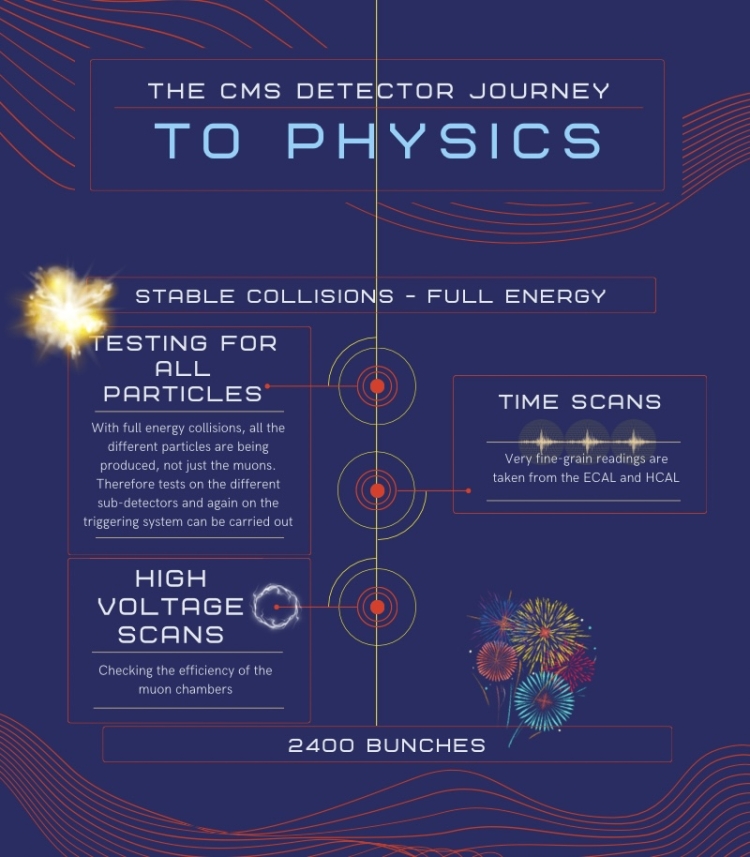
In Part 2, we look at what happens from the first injection of the proton beam into the LHC.
Here, we go through the last few stages before the collection of the data for physics analysis starts!
Part 3
Full Collision Energy Stable Collisions!
The proton bunches are accelerated up to their maximum energy of 13.6 Tera Electron Volts (TeV) - but the number of bunches has yet to reach the full amount at this point! Technically, physics analysis could already be done on data taken now, but since the amount of bunches in the LHC is still relatively low, the first moments are used as checks to finalise alignments and calibrations across all the sub-detectors. This is the first time that the final energy of the collisions is reached, and therefore the first time full functionality can be tested.
At this energy, there are lots of different types of particles produced from the collisions, and so the different sub-detectors that make up the CMS detector that have different specialisations, can be carefully looked at.
It is a key moment for the trigger system too. The Trigger system down-selects the collisions that may be relevant to the research being done so that they can be safely stored for later analysis. To store them all would mean a huge amount of useless data putting an incredible burden on the systems.
Programming the triggers is not trivial. With these first full energy collisions there is the quality of data, but since there are fewer bunches than normal, not quite as much of it. Therefore, all the data is recorded and the triggers deployed manually on the full dataset to check that they indeed would cut out just the less useful collisions.
This takes around a week of testing.

Time Scans - When to take readings
These are a type of test at the full collision energy carried out for the ECAL - the Electromagnetic calorimeter, measuring energies of electrons and protons - and the HCAL - Hadron Calorimetry system, measuring energies of hadrons, i.e. protons, neutrons, pions, and kaons.
During normal running, there is a gap between readings of 25 nanoseconds because each bunch of protons is 25 nanoseconds in front or behind their neighbouring bunch. Therefore any given reading belongs to one bunch or the next one.
However, during the time scans, the readout phase is moved in intervals of 1 nanosecond to make sure that everything is tested to a much finer grain and any corrections can be made on the collected results.
Voltage and time scans are also performed for the Tracker. The Tracker reconstructs the path of particles moving through the detector, and these scans optimise the efficiency of the reconstructions.
High Voltage Scan - Configuring the muon chambers
High Voltage Scans are tests carried out to maximise the efficiency of the muon chambers by tweaking their configuration. The muon chambers had also been checked during the cosmic runs - you can find out more about these in part 1 - but now, unlike in the initial tests, there are many more muons from the collisions passing through the chambers. To check the efficiency with just cosmic muons would take a very long time indeed.
Full Energy 2400 Bunches!
When the first beam was injected into the LHC, there were only 3 bunches of protons whizzing around the collider at any one point. They are then increased exponentially to 12, 75, 400 etc until 1200 bunches of protons. At halfway it then increases from 1200 to 1800, 2000, and finally 2400. See more details here.
The timing of the increase in the number of bunches is decided centrally by the LHC team in line with their safety procedures, and the teams at CMS adjust testing accordingly.
Of course, the frontiers of physics can be explored with lower numbers of bunches too - in fact, in previous Runs there were far fewer than today’s 2400 bunches, and important observations were made! But fewer bunches means less data, and that means that rarer phenomenon are not recorded often - if at all. For CMS scientists, the more data there is, the more chance there is to really dig deep on all the different outcomes from a collision. For example, a Higgs boson is produced only about one in 10 billion collisions, so in order to study this fascinating particle there have to be enough of them in the data. In 2023, CMS and ATLAS identified the production of four top-quarks from collision data, a process 4,000 times more rare than even the Higgs, and a key way to study the Higgs field on the most massive of fundamental particles.
During Run 3, since the final number of bunches is so much higher, the teams use the lower bunch numbers to conduct their tests rather than take any physics. This is because if anything needs to be changed, pausing data taking at 300 bunches for an hour means a lot less data is lost than pausing for an hour at 2400.
When we get to 2400, this is the maximum number of bunches for Run 3 and the real fun begins!

